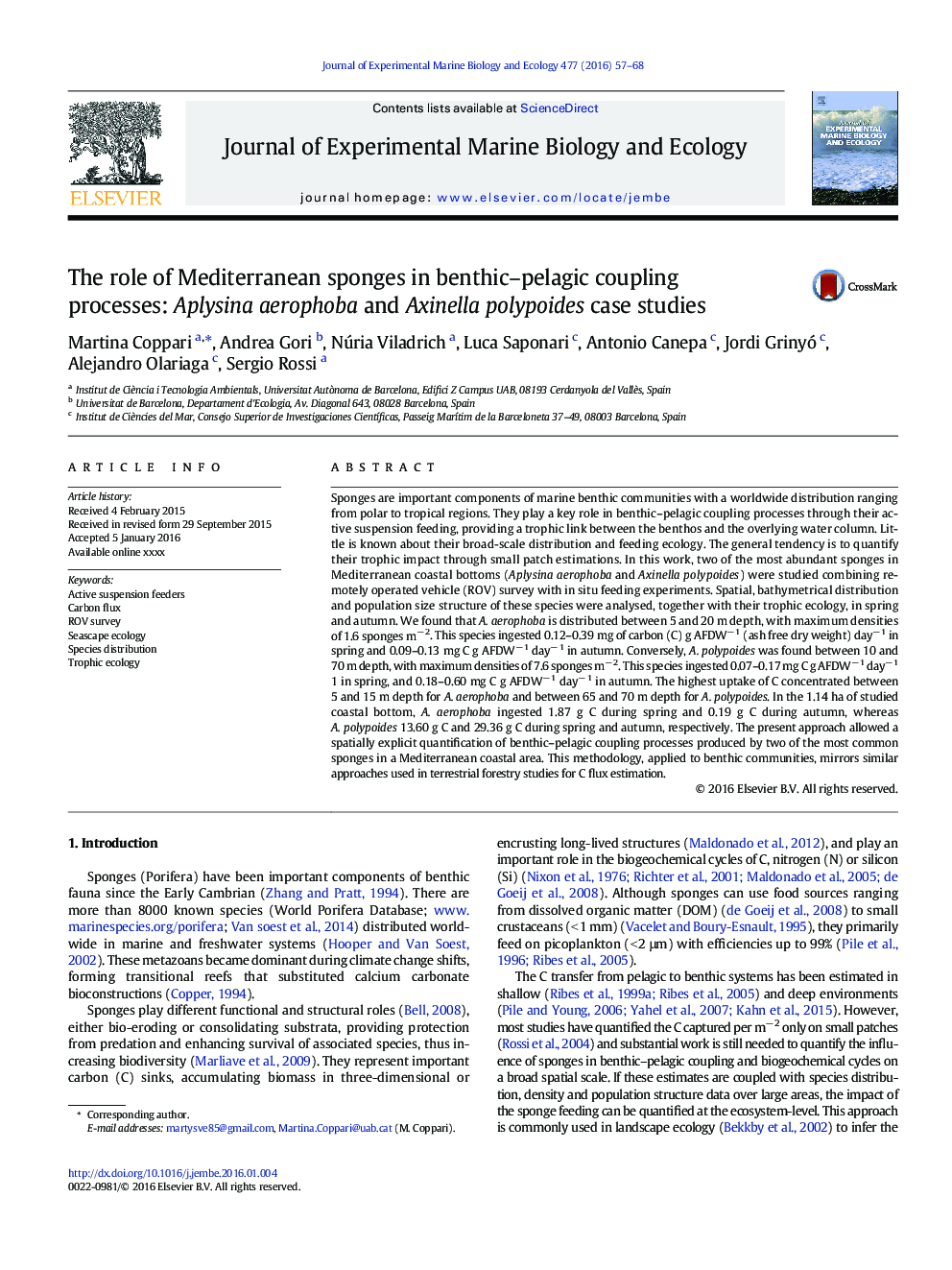| کد مقاله | کد نشریه | سال انتشار | مقاله انگلیسی | نسخه تمام متن |
|---|---|---|---|---|
| 6303752 | 1618398 | 2016 | 12 صفحه PDF | دانلود رایگان |
عنوان انگلیسی مقاله ISI
The role of Mediterranean sponges in benthic-pelagic coupling processes: Aplysina aerophoba and Axinella polypoides case studies
دانلود مقاله + سفارش ترجمه
دانلود مقاله ISI انگلیسی
رایگان برای ایرانیان
کلمات کلیدی
موضوعات مرتبط
علوم زیستی و بیوفناوری
علوم کشاورزی و بیولوژیک
علوم آبزیان
پیش نمایش صفحه اول مقاله

چکیده انگلیسی
Sponges are important components of marine benthic communities with a worldwide distribution ranging from polar to tropical regions. They play a key role in benthic-pelagic coupling processes through their active suspension feeding, providing a trophic link between the benthos and the overlying water column. Little is known about their broad-scale distribution and feeding ecology. The general tendency is to quantify their trophic impact through small patch estimations. In this work, two of the most abundant sponges in Mediterranean coastal bottoms (Aplysina aerophoba and Axinella polypoides) were studied combining remotely operated vehicle (ROV) survey with in situ feeding experiments. Spatial, bathymetrical distribution and population size structure of these species were analysed, together with their trophic ecology, in spring and autumn. We found that A. aerophoba is distributed between 5 and 20 m depth, with maximum densities of 1.6 sponges mâ 2. This species ingested 0.12-0.39 mg of carbon (C) g AFDWâ 1 (ash free dry weight) dayâ 1 in spring and 0.09-0.13 mg C g AFDWâ 1 dayâ 1 in autumn. Conversely, A. polypoides was found between 10 and 70 m depth, with maximum densities of 7.6 sponges mâ 2. This species ingested 0.07-0.17 mg C g AFDWâ 1 dayâ 1 in spring, and 0.18-0.60 mg C g AFDWâ 1 dayâ 1 in autumn. The highest uptake of C concentrated between 5 and 15 m depth for A. aerophoba and between 65 and 70 m depth for A. polypoides. In the 1.14 ha of studied coastal bottom, A. aerophoba ingested 1.87 g C during spring and 0.19 g C during autumn, whereas A. polypoides 13.60 g C and 29.36 g C during spring and autumn, respectively. The present approach allowed a spatially explicit quantification of benthic-pelagic coupling processes produced by two of the most common sponges in a Mediterranean coastal area. This methodology, applied to benthic communities, mirrors similar approaches used in terrestrial forestry studies for C flux estimation.
ناشر
Database: Elsevier - ScienceDirect (ساینس دایرکت)
Journal: Journal of Experimental Marine Biology and Ecology - Volume 477, April 2016, Pages 57-68
Journal: Journal of Experimental Marine Biology and Ecology - Volume 477, April 2016, Pages 57-68
نویسندگان
Martina Coppari, Andrea Gori, Núria Viladrich, Luca Saponari, Antonio Canepa, Jordi Grinyó, Alejandro Olariaga, Sergio Rossi,